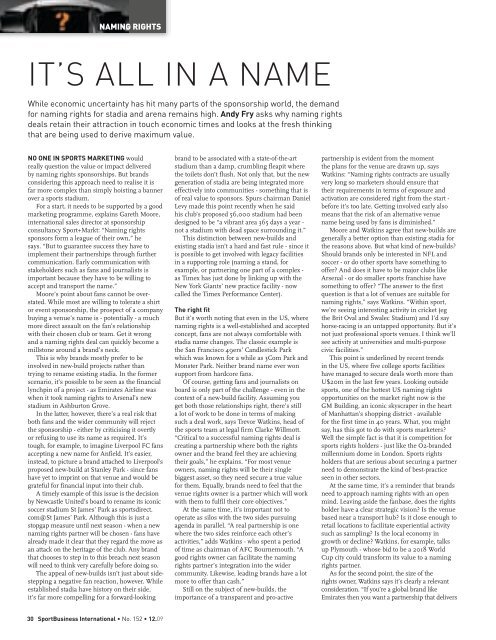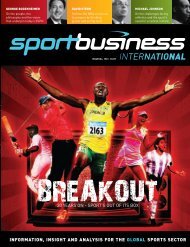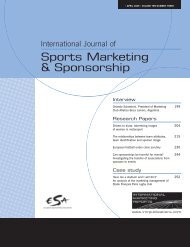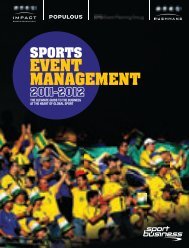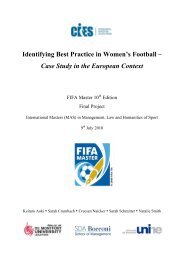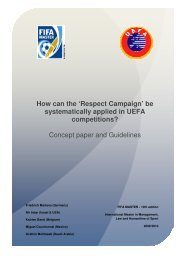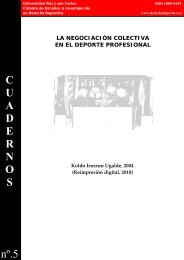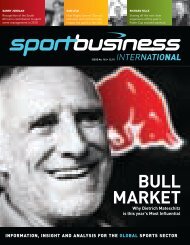01 cover sbi 152.indd - FIFA/CIES International University Network
01 cover sbi 152.indd - FIFA/CIES International University Network
01 cover sbi 152.indd - FIFA/CIES International University Network
Create successful ePaper yourself
Turn your PDF publications into a flip-book with our unique Google optimized e-Paper software.
NAMING RIGHTS<br />
IT’S ALL IN A NAME<br />
While economic uncertainty has hit many parts of the sponsorship world, the demand<br />
for naming rights for stadia and arena remains high. Andy Fry asks why naming rights<br />
deals retain their attraction in touch economic times and looks at the fresh thinking<br />
that are being used to derive maximum value.<br />
NO ONE IN SPORTS MARKETING would<br />
really question the value or impact delivered<br />
by naming rights sponsorships. But brands<br />
considering this approach need to realise it is<br />
far more complex than simply hoisting a banner<br />
over a sports stadium.<br />
For a start, it needs to be supported by a good<br />
marketing programme, explains Gareth Moore,<br />
international sales director at sponsorship<br />
consultancy Sport+Markt: “Naming rights<br />
sponsors form a league of their own,” he<br />
says. “But to guarantee success they have to<br />
implement their partnerships through further<br />
communication. Early communication with<br />
stakeholders such as fans and journalists is<br />
important because they have to be willing to<br />
accept and transport the name.”<br />
Moore’s point about fans cannot be overstated.<br />
While most are willing to tolerate a shirt<br />
or event sponsorship, the prospect of a company<br />
buying a venue’s name is - potentially - a much<br />
more direct assault on the fan’s relationship<br />
with their chosen club or team. Get it wrong<br />
and a naming rights deal can quickly become a<br />
millstone around a brand’s neck.<br />
This is why brands mostly prefer to be<br />
involved in new-build projects rather than<br />
trying to rename existing stadia. In the former<br />
scenario, it’s possible to be seen as the financial<br />
lynchpin of a project - as Emirates Airline was<br />
when it took naming rights to Arsenal’s new<br />
stadium in Ashburton Grove.<br />
In the latter, however, there’s a real risk that<br />
both fans and the wider community will reject<br />
the sponsorship - either by criticising it overtly<br />
or refusing to use its name as required. It’s<br />
tough, for example, to imagine Liverpool FC fans<br />
accepting a new name for Anfield. It’s easier,<br />
instead, to picture a brand attached to Liverpool’s<br />
proposed new-build at Stanley Park - since fans<br />
have yet to imprint on that venue and would be<br />
grateful for financial input into their club.<br />
A timely example of this issue is the decision<br />
by Newcastle United’s board to rename its iconic<br />
soccer stadium St James’ Park as sportsdirect.<br />
com@St James’ Park. Although this is just a<br />
stopgap measure until next season - when a new<br />
naming rights partner will be chosen - fans have<br />
already made it clear that they regard the move as<br />
an attack on the heritage of the club. Any brand<br />
that chooses to step in to this breach next season<br />
will need to think very carefully before doing so.<br />
The appeal of new-builds isn’t just about sidestepping<br />
a negative fan reaction, however. While<br />
established stadia have history on their side,<br />
it’s far more compelling for a forward-looking<br />
brand to be associated with a state-of-the-art<br />
stadium than a damp, crumbling fleapit where<br />
the toilets don’t flush. Not only that, but the new<br />
generation of stadia are being integrated more<br />
effectively into communities - something that is<br />
of real value to sponsors. Spurs chairman Daniel<br />
Levy made this point recently when he said<br />
his club’s proposed 56,000 stadium had been<br />
designed to be “a vibrant area 365 days a year -<br />
not a stadium with dead space surrounding it.”<br />
This distinction between new-builds and<br />
existing stadia isn’t a hard and fast rule - since it<br />
is possible to get involved with legacy facilities<br />
in a supporting role (naming a stand, for<br />
example, or partnering one part of a complex -<br />
as Timex has just done by linking up with the<br />
New York Giants’ new practice facility - now<br />
called the Timex Performance Center).<br />
The right fit<br />
But it’s worth noting that even in the US, where<br />
naming rights is a well-established and accepted<br />
concept, fans are not always comfortable with<br />
stadia name changes. The classic example is<br />
the San Francisco 49ers’ Candlestick Park<br />
which was known for a while as 3Com Park and<br />
Monster Park. Neither brand name ever won<br />
support from hardcore fans.<br />
Of course, getting fans and journalists on<br />
board is only part of the challenge - even in the<br />
context of a new-build facility. Assuming you<br />
get both those relationships right, there’s still<br />
a lot of work to be done in terms of making<br />
such a deal work, says Trevor Watkins, head of<br />
the sports team at legal firm Clarke Willmott.<br />
“Critical to a successful naming rights deal is<br />
creating a partnership where both the rights<br />
owner and the brand feel they are achieving<br />
their goals,” he explains. “For most venue<br />
owners, naming rights will be their single<br />
biggest asset, so they need secure a true value<br />
for them. Equally, brands need to feel that the<br />
venue rights owner is a partner which will work<br />
with them to fulfil their core objectives.”<br />
At the same time, it’s important not to<br />
operate as silos with the two sides pursuing<br />
agenda in parallel. “A real partnership is one<br />
where the two sides reinforce each other’s<br />
activities,” adds Watkins - who spent a period<br />
of time as chairman of AFC Bournemouth. “A<br />
good rights owner can facilitate the naming<br />
rights partner’s integration into the wider<br />
community. Likewise, leading brands have a lot<br />
more to offer than cash.”<br />
Still on the subject of new-builds, the<br />
importance of a transparent and pro-active<br />
partnership is evident from the moment<br />
the plans for the venue are drawn up, says<br />
Watkins: “Naming rights contracts are usually<br />
very long so marketers should ensure that<br />
their requirements in terms of exposure and<br />
activation are considered right from the start -<br />
before it’s too late. Getting involved early also<br />
means that the risk of an alternative venue<br />
name being used by fans is diminished.”<br />
Moore and Watkins agree that new-builds are<br />
generally a better option than existing stadia for<br />
the reasons above. But what kind of new-builds<br />
Should brands only be interested in NFL and<br />
soccer - or do other sports have something to<br />
offer And does it have to be major clubs like<br />
Arsenal - or do smaller sports franchise have<br />
something to offer “The answer to the first<br />
question is that a lot of venues are suitable for<br />
naming rights,” says Watkins. “Within sport,<br />
we’re seeing interesting activity in cricket (eg<br />
the Brit Oval and Swalec Stadium) and I’d say<br />
horse-racing is an untapped opportunity. But it’s<br />
not just professional sports venues. I think we’ll<br />
see activity at universities and multi-purpose<br />
civic facilities.”<br />
This point is underlined by recent trends<br />
in the US, where five college sports facilities<br />
have managed to secure deals worth more than<br />
U$20m in the last few years. Looking outside<br />
sports, one of the hottest US naming rights<br />
opportunities on the market right now is the<br />
GM Building, an iconic skyscraper in the heart<br />
of Manhattan’s shopping district - available<br />
for the first time in 40 years. What, you might<br />
say, has this got to do with sports marketers<br />
Well the simple fact is that it is competition for<br />
sports rights holders - just like the O2-branded<br />
millennium dome in London. Sports rights<br />
holders that are serious about securing a partner<br />
need to demonstrate the kind of best-practice<br />
seen in other sectors.<br />
At the same time, it’s a reminder that brands<br />
need to approach naming rights with an open<br />
mind. Leaving aside the fanbase, does the rights<br />
holder have a clear strategic vision Is the venue<br />
based near a transport hub Is it close enough to<br />
retail locations to facilitate experiential activity<br />
such as sampling Is the local economy in<br />
growth or decline Watkins, for example, talks<br />
up Plymouth - whose bid to be a 2<strong>01</strong>8 World<br />
Cup city could transform its value to a naming<br />
rights partner.<br />
As for the second point, the size of the<br />
rights owner, Watkins says it’s clearly a relevant<br />
consideration. “If you’re a global brand like<br />
Emirates then you want a partnership that delivers<br />
30 SportBusiness <strong>International</strong> • No. 152 • 12.09


